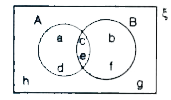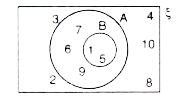Show that the following four conditions are equivalent:(i)A⊂B (ii) AB=φ (iii) A∪B=B (iv) A∩B=A
1 and 2)
A-B≠ϕ
x∈A,x∉B
not possible
A⊂B
x∈B
A-B=ϕ
1 and 3)
x∈AUB
x∈Aorx∈B
AUB=B
1 and 4)
x∈A∩B
x∈Aandx∈B
A=A∩B
A⊂B.
Topper's Solved these Questions
- BOOK - NCERT ENGLISHCHAPTER - SETSEXERCISE - SOLVED EXAMPLES34videos
SETS
- BOOK - NCERT ENGLISHCHAPTER - SETSEXERCISE - EXERCISE 1.39videos
SETS
- BOOK - NCERT ENGLISHCHAPTER - SEQUENCES AND SERIESEXERCISE - EXERCISE 9.56videos
SEQUENCES AND SERIES
- BOOK - NCERT ENGLISHCHAPTER - STATISTICSEXERCISE - EXERCISE 15.210videos
STATISTICS
Similar Questions
FOR ANY TWO SETS AandB , show that the following statements are equivalent: A⊂B (ii) A−B=φ (iii) A∪B=B (iv) A∩B=A.
View SolutionGiven, A = {Quadrilaterals}, B = {Rectangles}, C = {Squares}, D = {Rhombuses}. State, giving reasons, whether the following are true or false.
(i) B⊂C, (ii) D⊂B, (iii) C⊆B⊆A, (iv) D⊂A, (v) B⊇C, (iv) A⊇B⊇CView SolutionFrom the given diagram find:
(i) A∪B
(ii) A'∩B
(iii) A-B
(iv) B-A
(v) (A∪B)'
 View Solution
View Solutionif set B ={1,4,8,16,32,64} then which of the following is true? If not then mention why?
(i) 4∈B
(ii) 16∈B
(iii) 2∈B
( iv) 164∈BView SolutionDraw a Venn-diagram to show the relationship between sets A and B , such that A⊆B. Now shade the region representing :
(i) A∪B, (ii) B'∩A, (iii) A∩B, (iv) (A∪B)'View SolutionTwo sets A and B are such that A∩B=π. Draw a Venn-diagram to show the relationship between A and B. Shade the region representing :
(i) A∪B, (ii) (A∪B)', (iii) B-A, (iv) B∩A'View SolutionUse the given Venn-diagram to find:
(i) B-A
(ii) A
(iii) B'
(iv) A∩B
(v) A∪B
 View Solution
View SolutionVerify a−(b)=(a+b) for the following values of a and b. (i) a=21,b=18 (ii) a=118,b=125 (iii) a=75,b=84 (iv) a=75,b=11.
View SolutionShow that none of the operations given below has identity.(i) a∗b=a−b (ii) a∗b=a2+b2 (iii) a∗b=a+ab (iv) a∗b=(a−b)2 (v) a∗b=ab4 (vi) a∗b=ab2
View SolutionLet ∗ be the binary operation defined on Q. Find which of the following binary operations are commutative
(i) a∗b=a−b,∀a,b∈Q (ii) a∗b=a2+b2,∀a,b∈Q
(iii) a∗b=a+ab,∀a,b∈Q (iv) a∗b=(a−b)2,∀a,b∈QView Solution

